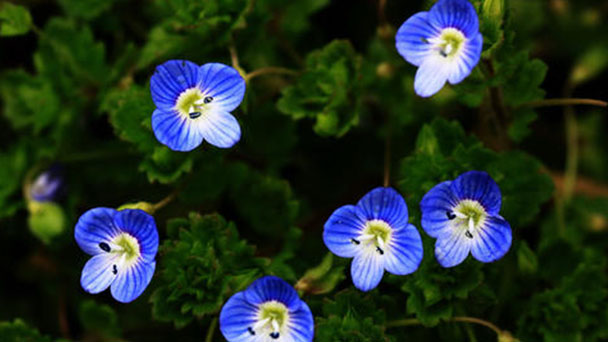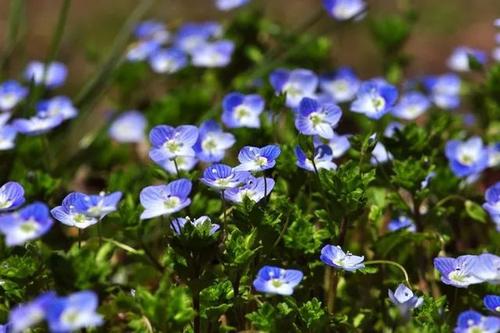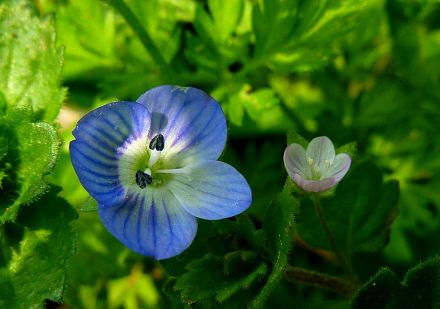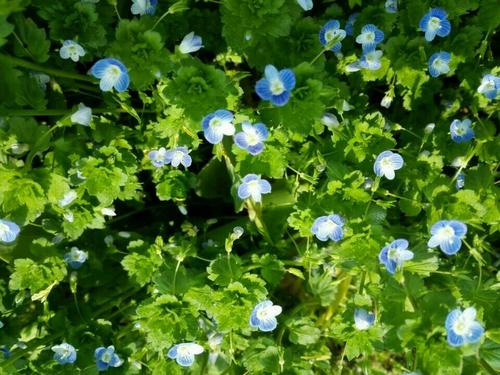Veronica Persica (Birdeye Speedwell) Profile
Written by Maggie
Oct 15 2021

Veronica persica, commonly known as birdeye speedwell, common field-speedwell, Persian speedwell, large field speedwell, bird's-eye, or winter speedwell, is a pilose annual to biennial herb in the family Scrophulariae. Stems are branched from base, lower voluminous ground, oblique, leaves opposite at stem base, upper alternate. Flowers are single in the axils of bracts, corolla light blue, with radial dark blue stripes throughout the growth, the south is more common, born in the field, roadside, is a common weed in early spring in eastern China; Veronica persica is also a common invasive plant. The whole grass of the plant can be used for medical treatment, rheumatism and pain, kidney deficiency and lumbago, external malaria and other diseases.
Veronica Persica is an annual or perennial broad-leaved weed. A. arabana is a regional malignant weed in the Yangtze river valley and north China. It has strong fertility and is difficult to control. veronica persica is mainly harmful to wheat, barley, spinach, stuffed vegetables, etc.
Veronica Persica Picture

Veronica Persica Morphological Characteristics
Veronica Persica Cauline Leaf
Veronica persica spreads many branching herbs, 10-50 cm tall. Stem is dense with two rows of multicellular pilose. Leaves are 2-4 pairs (called bracts of endophytic flowers in axils, see below), shortly stipitate, ovate or rounded, 6-20 mm long and 5-18 mm wide, base shallowly cordate, truncate or rounded, margin obtuse, sparsely pubescent on both surfaces.
Veronica Persica Flowers
The raceme of Veronica persica is very long; Bracts are alternate, homomorphic and nearly as large as leaves; Pedicels are longer than bracts, some more than 1 times; Calyx is only 3 -- 5 mm long at anthesis, up to 8 mm large at fruity stage, lobes ovate-lanceolate, lashes, three veins; Corolla is blue, purple, or blue-purple, 4 -- 6 mm long, lobes ovate to rounded, throat sparsely hairy; Stamens are shorter than corolla. Capsule reniform, ca.5 -- mm long, ca. 7 mm wide, glandular hairy, nearly glabrous when mature, reticulate veins prominent, groove Angle greater than 90 degrees, lobes obtuse, persistent style ca. 2.5 mm long, beyond groove. Seed of Veronica persica is abaxially with deep transverse stripes, ca. 1.6 mm.
Veronica Persica Native Habits
Veronica persica was born in the side of the road, ruderal, dry fields of summer crops begin, especially in wheat field, cause serious damage to crops, and become a cucumber Mosaic virus, lee poxvirus, aphids and so on the many kinds of microorganisms and pests, host in spinach, beet, barley crops such as the root of pathogenic bacteria (Aphanomyces cladogamus) and parasitic on this kind of plant.
Veronica Persica Propagation
Veronica Persica (Birdeye Speedwell) is propagated from seed.
Species taxonomy of Veronica Persica
Veronica Biloba L. Mant.
Plants 5-50 cm tall. Stem erect, usually midlower branched, sparsely white pilose. Leaves all opposite, short stipitate, rectangular to ovate-lanceolate, 5 -- 30 mm long and 4 -- 13 mm wide, base broadly cuneate to obtuse, margin sparsely and shallowly serrate, inflorescence 2 -- 40 cm long, each part sparsely white glandular hairs; Bracts smaller than leaves, lanceolate to ovate-lanceolate; Pedicels as long as bracts, extended or more or less downward curved after anthesis; Calyx laterally more lobed, lobed to 3/4, lobes ovate or ovate-lanceolate, acute, fruit as long as 4 -- 8 mm, with distinct 3 veins; Corolla white, blue, or purple, 3 -- 4 mm in diam., posterior lobes rounded, remaining 3 ovoid; Filaments shorter than corolla. Capsule 3-4.5 mm long, 4-5 mm wide, glandular hairy, nearly lobed to the base into two carps, lobes forked 30-45 degrees, lobes apically obtuse, persistent style much lower than the alcove. Seeds 1.2-1.5 mm long, with inconspicuous transverse wrinkles.
Veronica Campylopoda Boiss.
Plants 5-15 cm tall. Stem is erect, slender, unbranched or midlower branched, curving hairy.Leaves opposite, sometimes alternate, proximally short stipitate, leaf blade oblong or oblong-lanceolate, 4 -- 12 mm long, 2 -- 5 mm wide, entire or lower leaves inconspicuously serrate, somewhat hairy. Flowers are sparsely, 8-12 with racemes up to 10 cm long, racemes and pedicels white curved hairs mixed with glandular hairs; Bracts are long elliptic, smaller than leaves, entire or sparsely toothed; Pedicels filiform, often beyond bracts, to twice as long, fruiting erect, slightly curved or reflexed downward; Calyx lobes lanceolate, shortly acuminate, nearly 3 mm long, 3-veined, sparsely glandular hairy, laterally bifid not to the bottom;Corolla 2 -- 3 mm long, blue or bluish. Capsule subequal to calyx or slightly shorter, less than 4 mm wide, nearly lobed to base, two lobes obovate, forked into an Angle of 30-45 degrees, glandular hairy, style reaching the middle of the notch.
Veronica Cardiocarpa (Kar. et Kir.) Walpers
Plants are 5-15 cm tall. Stem is erect, slender, unbranched or midlower branched, curving hairy. Leaves opposite, sometimes alternate, proximally short stipitate, leaf blade oblong or oblong-lanceolate, 4 -- 12 mm long, 2 -- 5 mm wide, entire or lower leaves inconspicuously serrate, somewhat hairy. Flowers sparsely, 8-12 with racemes up to 10 cm long, racemes and pedicels white curved hairs mixed with glandular hairs; Bracts long elliptic, smaller than leaves, entire or sparsely toothed; Pedicels filiform, often beyond bracts, to twice as long, fruiting erect, slightly curved or reflexed downward; Calyx lobes lanceolate, shortly acuminate, nearly 3 mm long, 3-veined, sparsely glandular hairy, laterally bifid not to the bottom; Corolla 2 -- 3 mm long, blue or bluish. Capsule subequal to calyx or slightly shorter, less than 4 mm wide, nearly lobed to base, two lobes obovate, forked into an Angle of 30-45 degrees, glandular hairy, style reaching the middle of the notch. Seeds ovate, nearly 1 mm long, with 4-6 distinct horizontal stripes.2n=42
Xinjiang and western Tibet. Iran to India and the Soviet Union in Central and West Siberia.Health wasteland and thousands of hillside.

Veronica Didyma Tenore
Herbs scattered much branched, more or less pilose, 10-25 cm tall. Leaves only 2-4 pairs (bracts with flowers in axils, see below), short stipitate 3-6 mm long, leaf blade cordated to ovate, 5-10 mm long and 6-7 mm wide, 2-4 deeply obtuse teeth on each side, white villous on both sides. Racemes very long; Bracts leaflike, proximally opposite or entirely alternate;Pedicels slightly shorter than bracts; Calyx lobes ovate, apex acute, fruit slightly enlarged, three veins, sparsely hirsute; Corolla lavender, blue, pink, or white, 4 -- 5 mm in diam., lobes rounded to ovate;Stamen shorter than corolla. Capsule nearly kidney - shaped, densely glandular hairy, slightly shorter than calyx, 4-5 mm wide, groove about 90 degrees Angle, lobes apically rounded, veins inconspicuous, persistent style equaling or missing the groove.Seeds abaxially laterally striated, ca. 1.5 mm.
Veronica Ferganica M. Pop.
Herbs are erect, 1-7 cm tall, often reddish. Stem unbranched or branched, white pilose.Leaves opposite, petiole ca. 2 mm, distally subsessile, leaf blade ovate or ovate-oblong, 3 -- 10 mm long, 2 -- 5 mm wide, entire or lower leaves sparsely and shallowly serrate, glabrous above, sparsely pilose below. Inflorescences ca. 2 cm long, rachis and pedicels pilose and glandular hairy; Bracts lanceolate or striate, smaller than leaves; Pedicels longer than bracts, post floral curved upward; Calyx slightly enlarged after anastomosis, 3 -- 4.5 mm long, dorsal puberulent, margin red glandular hairs, lobes ovate, 3 veins faintly visible; Corolla white or pale blue, shorter than calyx, lobes ovate. Capsule obcorate, slightly shorter than calyx, 4 mm wide, lobes to middle, lobes forked 70 -- 90 degrees, lobes ovate, margin with red glandular hairs, persistent styles ca. 0.5 mm long. Seeds ovate-navicular, smooth, ca. 1 mm long.
Veronica Tenuissima Boris
Plants are 5-10 cm tall. Stem erect, glabrous or puberulent. Leaves only 4, arranged in a circle below inflorescences, rectangular or rectangular lanceolate, 3 -- 10 mm long, base tapering into a short stalk, entire, glabrous. Flowers many, scattered, integrated racemes, racemes more or less inflexed;Bracts much smaller than leaves, oblanceolate or nearly oblanceolate, entire; Pedicels long and slender, 3.5 -- 12 mm long, 1 -- 4 times longer than bracts, curved downward after flowering; Calyx 2 -- 2.5 mm long, equilobed to base, lobes lanceolate, glabrous, midvein conspicuous; Corolla blue, nearly 1 mm long. Capsule nearly 2 mm long and 2.5 mm wide, reformed, cleft to 2/3, lobes diverged at a 90 degree Angle, glabrous. Style 0.5-0.7 mm.Seeds ca. 0.7 mm, rectangular, abaxially slightly undulated.
Veronica Persica Distribution
Veronica Persica is originally from Eurasia. It is a naturalized roadside and wilderness weed in eastern and central China, Guizhou, Yunnan, eastern Tibet and Xinjiang (Yining). Veronica persica is native to western Asia and Europe.
Veronica Persica Uses
Medical Uses
Function: antipyretic.The main treatment is kidney deficiency, rheumatism, malaria.
Garden Uses
There are two germination peaks each year, respectively in late November and March - April. Veronica Persica (Birdeye Speedwell) has a strong ability to reproduce asexually, and often produces adventitious roots from its stems and regenerates into plants. Because of its strong ability to reproduce asexually, Veronica Persica can be planted on bare ground to quickly cover the ground.

Latest Updated
- Benefits of Bugleweed - 7 Science-backed Health Benefits
- Bugleweed Dangers & Side Effects - Is It Poisonous?
- How to Plant Evergreen Trees - What You Should Know
- When to Plant Evergreens - Grow Guide for Evergreen Trees
- 12 Wonderful Evergreen Shrubs for Your Garden
- 12 Popular Evergreen Plants with Pictures for Beginners
- When And How To Prune A Lilac Bush Like a Pro
- How to Grow & Care for Lilac Vine (Hardenbergia Violacea)
- Japanese Lilac Tree (Syringa Reticulata) Care & Propagation Guide
- Shumard Oak Pros and Cons - What to Know
Popular Articles
- Winter maintenance of Antirrhinum Majus
- How to Grow Terminalia Mantaly Tree
- How to Grow and Care for Crossostephium Chinense
- How to grow Antirrhinum Majus in spring
- Peristeria Elata (Dove Orchid) Profile: Info & Care Guide
- Underwatered Snake Plant (Sansevieria Trifasciata) - Signs And How To Fix
- How to Care for Brazilian Jasmine Plant (Mandevilla Sanderi)
- How to Grow & Care for Graptopetalum Purple Delight in Summer
- Rosa Chinensis (China Rose): Plant Growing & Care Tips
- How to Care for Baby Sun Rose (Aptenia Cordifolia)